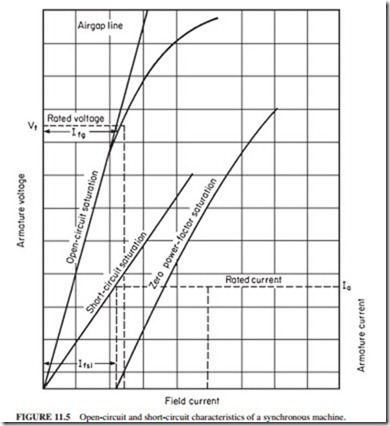NO-LOAD AND SHORT-CIRCUIT VALUES
The no-load or open-circuit voltage is generated in the armature windings of a synchronous machine when the armature terminals are open-circuited and the rotor is rotating at synchronous speed while the field winding is energized. The induced open-circuit voltages in the three phases are given by
Figure 11.5 illustrates a typical open-circuit saturation curve of a synchronous machine. It represents the no-load characteristics of the machine. The air gap line represents the extension of the straight-line portion of the saturation curve. Figure 11.5 also illustrates a typical short-circuit saturation characteristic of a synchronous machine. It is obtained by shorting the terminals of the armature together while the rotor is rotating at synchronous speed and the field current is increased from zero to a small value. The short-circuit saturation curve is a plot of the variations of the current in the shorted armature windings ver- sus the field current.
The zero power factor saturation characteristic is obtained by overexciting the machine while it is connected to a highly inductive load or an idle running synchronous motor. The terminal voltage of the machine being tested is varied while its armature current is held con- stant at the rated value by adjusting the excitation of the load and the machine being tested. This characteristic is important for the analysis of a synchronous motor.
Related posts:
Incoming search terms:
- short circuit of synchronous machine on no load
- short circuit of a synchronous machine on no load
- open and short circuit test of synchronous generator
- no load characteristics of synchronous generator
- synchronous generator on no load
- no load short circuit analysis of synchronous generator
- Short circuit of synchronous machine at no load full load
- no load test on a synchronous machine
- short circuit characteristics of synchronous machine
- short circuit characteristics of synchronous generator
- short circuit and open circuit test for synchronous machine
- open and short circuit test of alternator
- shrot cricuit sycronous machine on load
- short circuit of synchronous machine at no load
- Short circuit of synchronous machine at no loads
- synchronous generator saturation curve
- Short circuit of a synchronous machine on no loaded
- open-circuit saturation curve of a synchronus generator
- S c of syn machine on load
- short and open circuit characteristic curve
- short circuit and no load test on generator
- short circuit test in synchronous machine
- short circuit on loaded synchronous machine
- Short circuit of syncronous machine no load
- short circuit of synchronous machine on no load and loaded
- short circuit current in synchronous machine
- Short circuit of
- short circuit of synchronous machine at no load na d full load
- open curit of syncons motor
- open circuit saturation curve of a synchronous generator
- open circuit characteristics of synchronous machine
- No load charateristic of synchronous generator
- No load characteristics of synchronous motor
- no load characteristics of synchronous generator or alternetor
- no load characteristics of synchronous generator conclusion
- why short circuit test in synchronous machine is straight line charctristcs
- No load characteristic of a synchrounous machine
- no laod and short circuit test 3phese alternator
- Load characteristics of synchronous generator
- no load of synchronous generator
- no load test of an alternator
- no load test on synchronous motor
- open circuit and short circuit test for synchronous generators
- Open Circuit and Short Circuit Characteristics of Synchronous alternator
- open circuit &short circuit test of synchronous generator
- open cicuit and shot circit curve for alternaror
- open and short circuit characteristics of synchronous generator
- oc SC characteristics of alternator
- oc and sc test on synchronous machine
- no-load characteristic of synchronous generator

